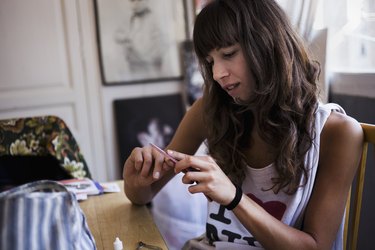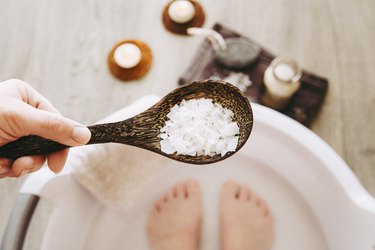
Ugh, is that a wart? They're unwelcome, sure, but warts aren't all that bad. They're benign skin growths caused by the human papillomavirus (HPV), according to the American Academy of Dermatology (AAD). They can grow anywhere on the body but commonly pop up on fingers or the legs or beard area (when spread by shaving). If you have warts on the soles of your feet, these are called plantar warts.
"This is a very, very common infection. Most people in their lives will have a wart or two — or four," Cameron West, MD, board-certified dermatologist and dermatopathologist at U.S. Dermatology Partners in Wichita, Kansas, tells LIVESTRONG.com. What's more, warts are frequently transmitted from person-to-person.
Video of the Day
Video of the Day
A wart may be unsightly, but it's not particularly harmful, Dr. West says. "The body's immune system allows the wart to fly under-the-radar, so the body isn't amped to launch a vigorous attack on the wart," he explains. Basically, a wart can stick around until the body recognizes it doesn't belong and then decides to get rid of it.
Yes, warts can heal naturally. Eventually, they usually go away on their own, per the AAD.
To speed up that process, you can get warts removed by your doctor through various in-office methods, from liquid nitrogen (freezing it) to certain injections that create an inflammatory reaction, says Dr. West.
But if you're looking to get rid of your wart at home, here are some natural remedies for warts you can try.
1. Compound W + Duct Tape + Filing
This over-the-counter remedy isn't necessarily "natural," but it is a popular home remedy for wart removal. Compound W ($6.96, Amazon) is a salicylic acid-based product, and Dr. West says it works for a lot patients, as it causes irritation of the wart. He advises applying Compound W at night.
Next, grab duct tape ($6.98, Amazon). Duct tape is truly a do-it-all tool — and it can help get rid of your warts, too. After applying Compound W, wrap duct tape around the wart and go to sleep. The duct tape acts as an occlusive, which provides a barrier on skin to keep what's below moist. "In the morning, the wart will be white, mushy and soft," Dr. West says.
Though you shouldn't cut off a wart, you should trim it. The third step is to cut an emery board ($2.49 for 24, Amazon) into small strips. Using one strip, file down the soft, mushy wart and throw the emery board piece in the trash. (It has wart virus on it now.) This process helps physically destroy the wart. (Taking off the top of the wart can also help medicine penetrate deeper, Alex Kor, DPM, a podiatrist in Lebanon, Indiana, tells LIVESTRONG.com. A little bleeding may be normal.)
Overall, this three-step process creates an inflammatory response that the body recognizes and then works to fight off the virus. It can help get rid of the wart faster, Dr. West says.
2. Cimetidine Tablets
This antacid is sold under the brand name Tagamet ($16.54, Amazon). Traditionally, it's used for heartburn and acid indigestion, but interestingly enough, some research suggests it can help speed the healing of warts, too.
"I've seen it be effective in plenty of cases, though it doesn't do an amazing job," Dr. West says.
This is based on older Archives of Dermatology research from June 1996 on 18 adults, which found that 16 of them saw an improvement in their wart or their wart completely went away after taking cimetidine for three months. It may be that the medication affects the immune system in some way, though the exact mechanisms aren't known.
It's also worth noting that some randomized trials found cimetidine to be no more effective than a placebo, so this one is a bit of a gamble, although there's no real harm in trying it.
3. Topical Retinoids
Retinoids are vitamin A derivatives that are used in both acne treatment and to stimulate collagen production in skin, with the goal of smoothing out fine lines and wrinkles. Some research suggests these creams and gels may even be useful for wart treatment.
According to a January 2021 review and meta-analysis in Dermatologic Therapy, topical treatment — with tretinoin 0.05% cream, isotretinoin 0.05% gel, vitamin A 2% ointment or adapalene 0.1% gel plus occlusion — removed the wart in 64 percent of cases, on average, though treatment needed to be used for one to three months.
It may be that retinoids cause inflammation, though the authors say that's not what their review found, so the 'why' behind why this works is still being considered.
Still, if you use retinoids as part of your facial skin-care regimen, you could try applying the product to your wart, too.
What About Apple Cider Vinegar (and Other Natural Remedies for Warts)?
One evaluation on wart treatments on YouTube, published March 2023 in JAAD International, revealed that one-third of videos by non-medical professionals and 7 percent of videos by professionals suggested a natural treatment, including:
- Apple cider vinegar
- Tea tree oil
- Banana peel
- Castor oil
- Baking soda
- Onion
- Lemon juice
- Aloe vera
- Honey
- Garlic
- Potato
The authors of this research letter advise being cautious when using these remedies, as none have been shown to be effective, and some can cause side effects. For example, garlic can cause skin burns.
Though apple cider vinegar in particular is often recommended as a natural remedy for warts, there's a lack of data showing that it works. You should also be cautious when applying acidic foods to the skin, such as apple cider vinegar and lemon juice, as they can cause irritation.
How to Prevent Warts
Warts can spread through sweat, as they tend to like warm, moist environments, Dr. Kor says. After your feet are wet or sweaty from exercise, change socks or wear sandals to allow them to air out. (Just don't walk around with bare feet in locker rooms or other public places, where you can catch a wart.)
One thing you should try to resist? Picking. "I try to encourage patients to keep their hands off their warts. That can frequently spread warts to other locations," Dr. West says.
And if you do touch a wart (your own or someone else's), make sure to wash your hands thoroughly afterward. And of course, consistent hand-washing in general can prevent a number of ills, including warts.
When to See a Doctor About Warts
Most often, you can treat a wart at home, but these are times when you'd want to see a doctor. These include:
- You have a wart around your nails — get it checked by a dermatologist because, "These have a bit of a higher likelihood of having an HPV subspecies that can cause skin cancer," Dr. West explains
- You have a wart on your face — see a dermatologist to treat it in the best way possible that avoids scarring
- You have diabetes and the wart is on your foot
- If these at-home remedies didn't work for you and you'd like the wart to be removed
- American Dermatology Association: “Warts: Overview.”
- Archives of Dermatology: “Cimtidine Therapy for Recalcitrant Warts in Adults.”
- Dermatologic Therapy: “Topical and systemic retinoids for the treatment of cutaneous viral warts: A systematic review and meta-analysis.”
- JAAD International: “Quality evaluation of YouTube videos as a source of information on warts.”
Is this an emergency? If you are experiencing serious medical symptoms, please see the National Library of Medicine’s list of signs you need emergency medical attention or call 911.


